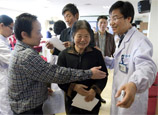
BEIJING, May 4 (Xinhua) -- China deserves credit for its rapid response to the outbreaks of H7N9 avian influenza, and its early openness in the reporting and sharing of data, a prestigious scientific journal has said.
"Today, some commentators view its reaction to H7N9 with mistrust. But from all the evidence so far ... China' s response to the virus is next to exemplary," London-based Nature said in an editorial in its online edition on April 24.
China reported the H7N9 outbreak to the World Health Organization (WHO) on March 31, just six weeks after the first known person fell ill. It has also shared all the sequences with the WHO, and live virus with the WHO and other laboratories, the editorial said.
"Chinese President Xi Jinping added political clout ... when he called for an effective response, and said that the government must ensure the release of accurate information about the outbreaks," the editorial noted.
China has distributed diagnostic tests to hospitals and research labs across the country. The response, spearheaded by the Chinese Center for Disease Control and Prevention in Beijing, has united clinicians, virologists, and epidemiologists. Live-bird markets at which H7N9 has been found have been shut down, and birds culled, it said.
Some critics have questioned the time between the first person falling ill on Feb. 19 and China's first announcement about the virus, and have asked whether the announcement was deliberately delayed.
"This is unfair," the editorial said. "With just a handful of severe pneumonia cases caused by the virus by mid-March, it is impressive that China realized as quickly as it did that something was amiss."
It took the United States, which has one of the world's most advanced disease-surveillance systems, an almost identical amount of time to identify a novel H3N2 swine virus that caused serious illness in a child in 2011, it added.
The editorial said it is crucial for China to continue its openness over the H7N9 outbreaks.
"In particular, it must promptly report any evidence of human-to-human spread," it said, adding that there are areas that need improvement.
Case reports should be published in full in journals or online as quickly as possible. It is also important that sequences from as many cases as possible are submitted to publicly accessible databases, it said.
Observers should continue to scrutinize China's response to H7N9, but they should also give credit where credit is due. "It is time to recognize that China has changed," it said.
















 In pictures: Henan construction site collapse kills 7
In pictures: Henan construction site collapse kills 7


![]()
